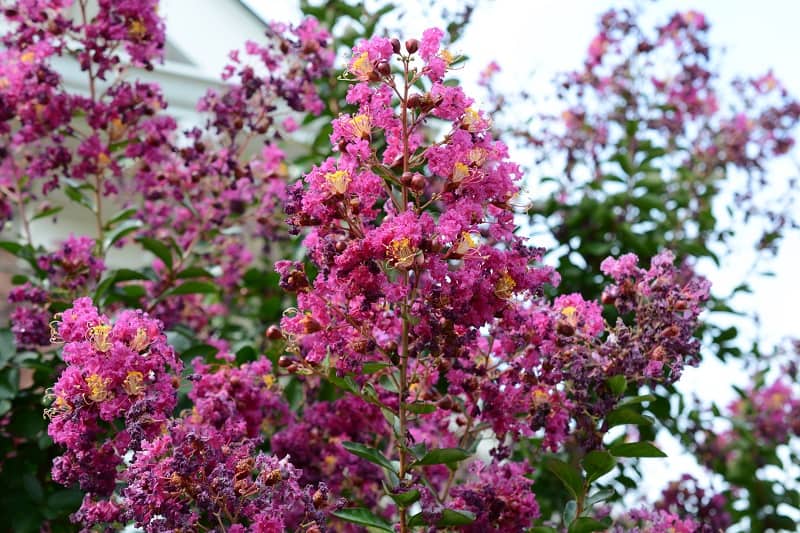
Crepe myrtle, with the scientific name Lagerstroemia, comprises around 50 species of evergreen trees and shrubs. These trees are native to northern Australia, Southeast Asia and parts of Oceania. They can grow up to 20 feet in height, have showy summer flowers and attractive bark, and are grown in warmer climates around the world. They are easy to grow, but may also be prone to diseases that could kill them unless they are treated promptly.
How to save a dying crepe myrtle
1. Know how to identify the signs of a dying tree.
The common signs of a dying tree include a bent structure, cracks on the trunk, fungi or mushrooms showing signs of decay, dried-up wood, and few leaves or no leaves at all.
2. Determine the problem.
You need to ascertain exactly why your crepe myrtle is dying. You may need to consult an arborist or tree professional to do this, to have a greater chance of saving your tree.
3. Ensure you are watering correctly.
Crepe myrtle trees can be negatively affected by too much or too little water in the soil. Like other living beings, they can die from dehydration. Make sure that the area where your trees are planted has sufficient drainage, and water them for 30 seconds to two minutes to give them a good soaking. Do not drown the soil with too much water. If you do not have much time to water the trees, set up automated sprinklers to ensure that they are adequately watered.
4. Follow a proper mulching technique.
Mulching can help nourish the soil around your trees but, if done incorrectly, it could cause damage instead. Do not put too much mulch around the base; use just enough so the roots can breathe. The mulch should have direct contact with the roots, so be sure to dig at least five inches into the ground. Only apply 1.5 inches of mulch to prevent problems like bacterial and fungal diseases.
5. Use fertilizers appropriately.
Avoid using too much fertilizer and be sure to test the soil first. Follow the instructions to get the full benefits, or consult tree professionals.
6. Ensure that you are pruning the trees properly.
Prune affected areas to remove diseased plant parts and unhealthy branches. Be sure to sanitize your pruning tools afterwards.
How to determine if your crepe myrtle is dying?
To determine whether your crepe myrtle is dying, do a scratch test on the stem’s lower base. If it is green, the tree is still alive; if not, it may or may not be alive, but you will have to wait a while to be sure. Cold winter months may kill the top growth, but the roots may still be alive. Wait and see if new shoots develop.
Continue to water but make sure you are giving just enough, since overwatering could drown the roots. During their dormant stage, the trees do not need much water. These trees are hard to kill, so it may take weeks or even months before you can really determine whether or not they are dying.
Signs that your crepe myrtle is dying or dead
There is physical damage, late leafing or no blooms
These trees are prone to damage by landscaping equipment because they have thin bark. Check for physical damage to the trees or if they are late to leaf in the spring. Take special note if they have not produced any flowers by late June. Some of these are dormant for longer, so if you do not see signs of damage or disease, there may still be no cause for worry.
You notice pests like aphids or scale insects
Pests could attack and weaken the trees, and could eventually kill them. Aphids and scale insects suck sap from plant tissue, and the former excrete a sticky fluid called honeydew. Spray these pests with a strong blast of water or use insecticidal soap or neem oil to eradicate them.
You notice fungal infections
Fungal diseases can damage your trees. One of these is sooty mold, which can develop due to the honeydew excreted by pests. You need to get rid of the pests first, and once they have been removed you can get rid of the sooty mold by washing it off.
Powdery mildew is a fungal infection that results in white layers on the shoots, buds and leaves. Prune off the affected areas and ensure that the trees get enough sunlight. You may also use a fungicide to control this.
Another common fungus is the Cercospora leaf spot, characterized by irregular dark spots on the older leaves from mid to late summer. Be sure to prune off affected parts to prevent the spread of the infection.
Conclusion
There are numerous ways to save a dying crepe myrtle, depending on the cause of the tree’s declining health. You need to ascertain the problem to ensure that you do not further damage the tree by attempting the incorrect treatment. Also ensure that you are following the proper mulching techniques, pruning and fertilizing the trees correctly, and following an appropriate watering schedule.
Image: istockphoto.com / MitchelC14